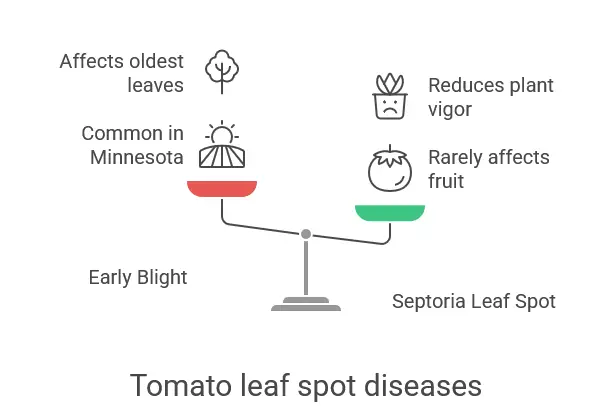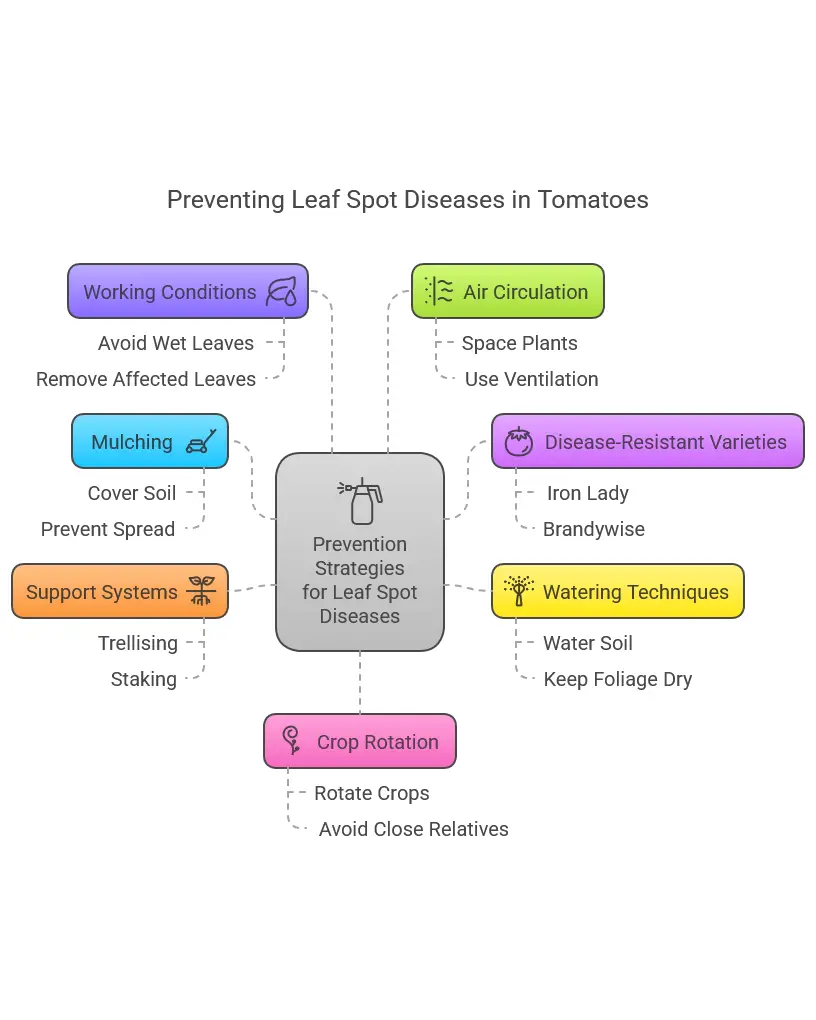We use affiliate links to run our site. When you buy through links on our site, we may earn an affiliate commission, without any added cost to you. Learn more
Hey there, fellow gardeners! If you’ve ever noticed brown spots on your tomato leaves, you’re not alone. This pesky problem is something many of us face, and it can seriously mess with our tomato plants’ health and yield.
The main culprits behind these brown leaf spots are fungal diseases like early blight and septoria leaf spot. They love humid conditions and can easily spread when water splashes onto the leaves.
You can read more about 9 Deadly Tomato Pests That Can Ruin Your Tomato Yield here.
So, understanding how to spot these issues, what causes them, and how to manage them is super important for keeping your tomatoes thriving.
In this guide, we’re going to break down everything you need to know about brown leaf spots on tomatoes—from identifying the symptoms to tackling them with treatments and prevention strategies. We’ll even touch on some organic options and talk about breeding resistant varieties.
Symptoms and Causes of Brown Leaf Spot
Alright, let’s get to the heart of the matter—what do those brown spots on tomato leaves look like?
You’ll often see brown to black spots that may have a ring pattern. As these spots spread, the leaves might start to yellow and eventually drop off.
The main offenders here are two types of fungi: Alternaria solani, which causes early blight, and Septoria lycopersici, responsible for septoria leaf spot. These fungi thrive in damp conditions and can spread like wildfire through splashing water from the ground.

If you live in places like Minnesota, early blight might be a familiar foe; it’s one of the most common diseases affecting tomatoes there. The spores can survive in leftover plant debris and even in weeds, so they’re always lurking around, ready to pounce on your new plants.
Septoria leaf spot is a bit sneaky—it doesn’t usually attack the fruit directly, but can really sap the energy from your plants if not dealt with.
How to Treat Septoria Leaf Spot
It is very difficult to treat the leaves that are already affected by the fungus. Your best bet would be to remove the affected leaves or the whole plant (if most of the leaves are infected) so that the rest of the plants in your garden do not get affected. You can safely remove up to a third of your tomato plant’s leaves without hurting its yield.
Also, consider mulching around the base of your plants. This simple step can reduce soil splash and help keep those fungal spores at bay.
Should you use a fungicide?
Most home garden tomatoes do not need to be treated with a fungicide. In fact, treatment with a fungicide can actually lead to problems such as toxicity, resistance development, and decreased fruit yields.
You can read more about the devastating effects of applying fungicides in your garden here.
Consider using beneficial microbes like *Trichoderma Harzianum*. These little guys have shown promise in managing septoria leaf spot without relying on synthetic chemicals.
How to prevent Leaf spot diseases in tomatoes:
Now that we’ve tackled treatment, let’s talk prevention! Preventing brown leaf spots before they become a problem is way easier than trying to fix them later.


Cover the soil below the tomato plants with mulch:
The best way to treat the leaf spots is to cover the soil below the tomato plants with mulch. This will help to prevent the spread of the disease and also protect the plants from further infection.
At the end of each season, make sure to clean up any leftover plant debris—this reduces the chances of those pesky fungal spores overwintering in your garden.
Use disease-resistant varieties:
Another key tactic is to choose disease-resistant varieties of tomatoes when you plant next season. Varieties like Iron Lady and Brandywise have shown resistance to leaf spot diseases, making them fantastic options for savvy gardeners looking to minimize problems.
Don’t pour Water on the leaves:
The best way to prevent the disease is to water the soil, not the leaves. This will help to keep the foliage dry and reduce the chances of the fungus spreading.
If the disease does occur, remove any affected leaves as soon as possible. This will help to prevent the fungus from spreading further.
We discussed the ideal watering technique for plants in this post, go and read it first if you haven’t done it already.
Use Stakes or trellis to support your tomatoes:
Trellising tomatoes can help to prevent tomato leaf spot diseases. By using a trellis, the plants are able to grow more upright, giving them a better chance of avoiding disease.
Furthermore, by staking the plants, you create an elevated area for them to grow above the ground, which also helps to avoid disease.
Read more about the tomato support system here.
Don’t work in tomato plants when the leaves are wet:
When leaves are wet, they are more susceptible to disease and fungi. Working in wet tomato plants puts workers and plants at risk for these diseases and fungi.
Make sure you have good air circulation around the plants:
Air circulation is important for preventing leaf spot diseases. If air circulation is restricted, fungal spores can accumulate, leading to disease.
Space the plants far enough so that they don’t share the same air circulation path, using natural or artificial ventilation, or using a greenhouse.
Use Crop Rotation methods:
From a soil science perspective, rotating crops is an effective way to manage pests and promote crop health. Changing where you plant your tomatoes each year helps break the cycle of disease by preventing pathogens from building up in the soil.
In addition, rotating crops helps reduce soil erosion and increases the stability of the soil structure.
Avoid planting tomatoes or their close relatives (like peppers and eggplants) in the same spot repeatedly.
Conclusion:
To wrap things up, tackling brown leaf spot is all about being proactive and resourceful. Recognizing those brown spots early means you’re already ahead of the game. Remember, each step you take towards managing this disease adds up, so why not start today?
I hope this post was helpful to you. You can read a ton of tomato-related articles here.
If you like the post, please feel free to share it with others.
Amazon and the Amazon logo are trademarks of Amazon.com, Inc, or its affiliates.


Hi there! My name is Prasenjit and I’m an avid gardener and someone who has grown a passion for growing plants. From my hands-on experience, I have learned what works and what doesn’t. Here I share everything I have learned.






